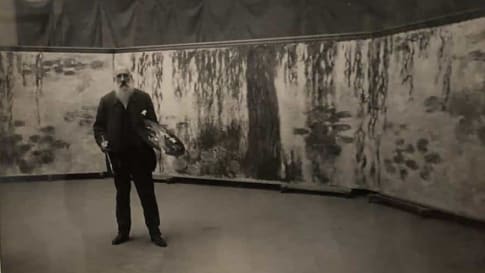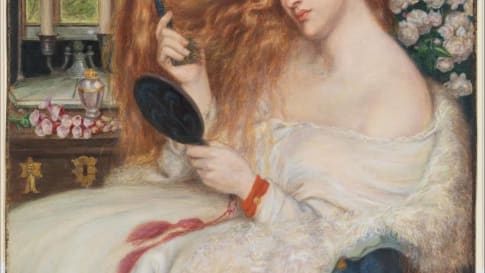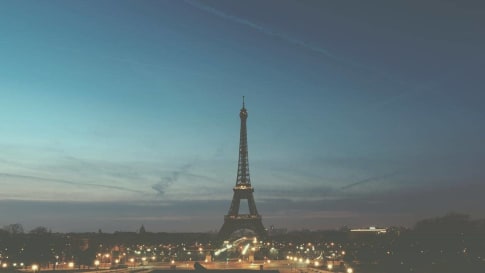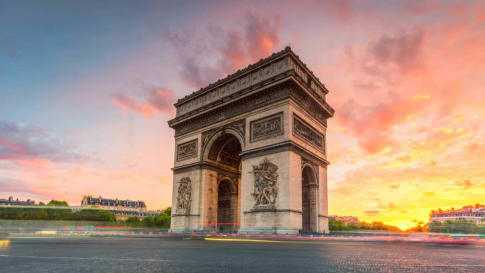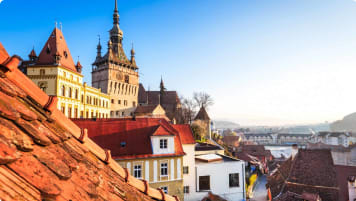Following Monet
Join Odyssey Traveller, one of the best small group tour companies for Europe, as we follow French Impressionist master Claude Monet (1840-1926) to the beloved places he painted joined by local guides in France on this 20-day European tour. Each day our small group journey visits key destinations that influenced Monet. Join like minded people be they couples or solo travellers on this escorted tour. Minimal Single supplement charged to Solo travellers.
From A$15,450AUD
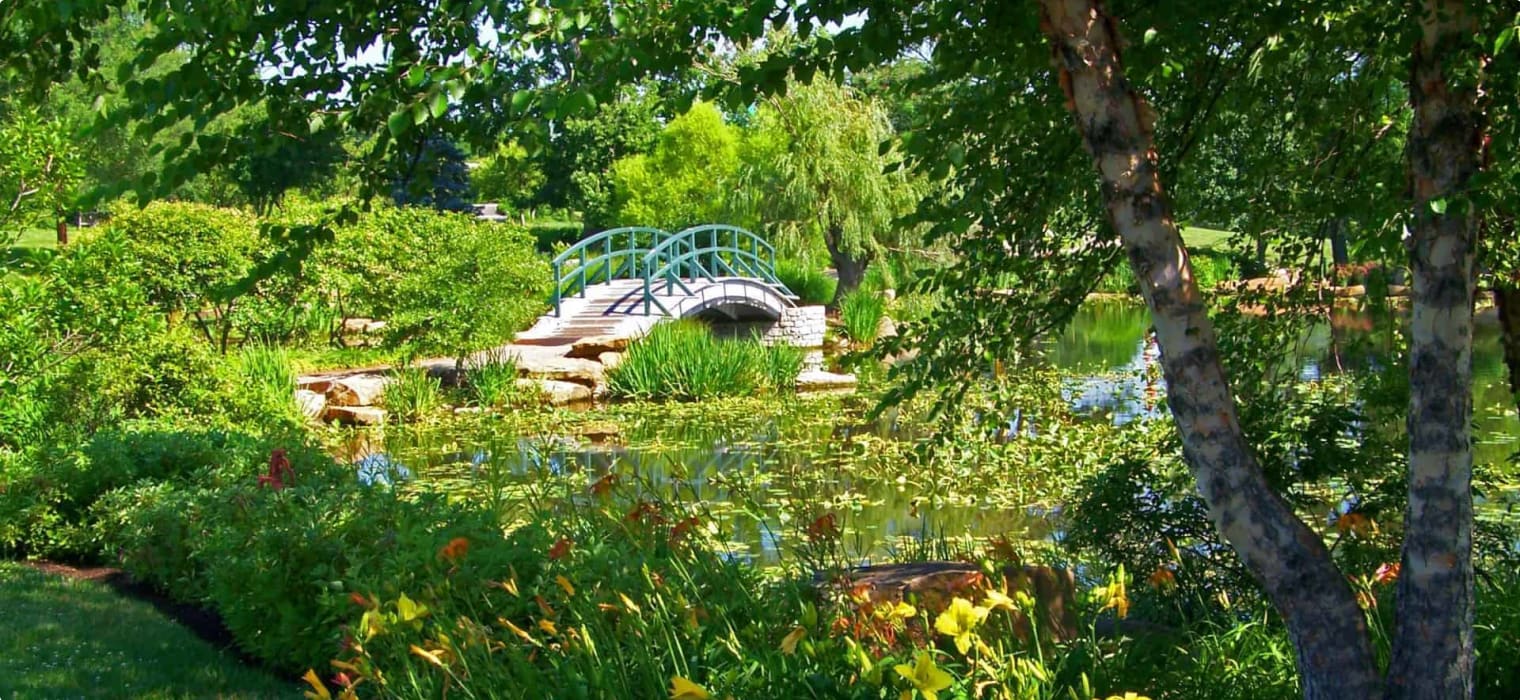
Highlights
- 1. View Monet's paintings in the Musée Marmottan Monet, Musée de l’Orangerie, and Musée D'Orsay.
- 2. See Monet's famous garden and water lily pond in Giverny, which inspired his Water Lilies series.
- 3. Walk the pebbled beaches of Etretat, a resort framed by incredible white cliffs that drew Monet and other Impressionists to its shoreline.
- 4. Explore the historic quarters of Rouen, whose Gothic cathedral inspired Monet's 31-canvas Rouen Cathedral series.
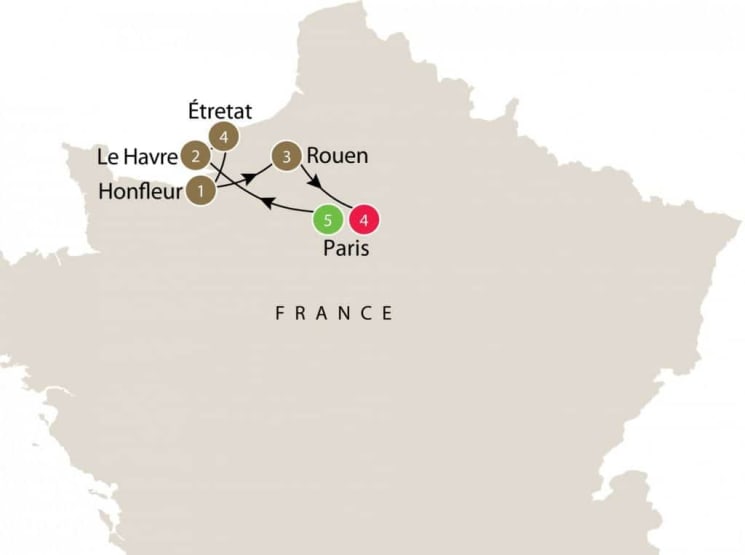
Departure Dates
| Departure Date | Price |
|---|---|
| 14 April 2025 Ends 03 May 2025 • 20 days A$16,150 Twin A$17,250 Single Available | Selected |
| 08 September 2025 Ends 27 September 2025 • 20 days A$16,150 Twin A$17,250 Single Available | |
| 13 April 2026 Ends 02 May 2026 • 20 days A$16,150 Twin A$17,250 Single Available | |
| 07 September 2026 Ends 26 September 2026 • 20 days A$16,150 Twin A$17,250 Single Available |
Following Monet: a small group tour across France
Join Odyssey Traveller as we follow French Impressionist master Claude Monet (1840-1926) through his beloved places in France on this 20-day tour. This programme will include visits to Monet's hometown Le Havre, his favourite resort retreats in the historic Normandy region, the museums that hold his famous water lily and wisteria paintings in Paris, and a stroll through his garden in Giverny, a beloved sanctuary that Monet himself has proclaimed his “most beautiful masterpiece".
This fully escorted tour features an Odyssey Program Leader and a handful of local guides who will discuss Impressionism, Monet's life and relationships, and how his unique techniques and art philosophy ushered in a major art movement in Europe.
The Birth of Impressionism
A seminal work in the history of Impressionism is Monet's Impression, Sunrise (French: Impression, soleillevant, 1872) which depicts a harbour in his hometown, Le Havre. As it is an impression, the painting does not have clear silhouettes. Monet instead chose to focus on the sunrise’s reflection on the water, adding vague forms in the background.
This is a radical break from French conventional art practices, at a time when painters adhered to the tastes of the Paris-based Académie des Beaux-Arts (Academy of Fine Arts) which favoured realistic styles and historical, mythological, or allegorical subject matters. They also emphasised painting in the studio, away from the outside world, and curated the annual Salon, a major exhibition for French and foreign painters.
A band of artists, which included Monet, got tired of the rigid rules of academic painting and decided to break from tradition by painting outdoors (en plein air) to capture nature, depicting common scenes, and focusing on light, movement, and fleeting impressions instead of static, realistic portrayals. His Impression, Sunrise appeared in the group's first exhibition.
Journalist and critic Louis Leroy derisively called the group the “Impressionists” after Monet’s painting. He wrote, “Wallpaper in its embryonic state is more finished than that seascape.” Despite the harsh criticism, the group used the name for themselves.
The critics--and perhaps even Monet himself--would not have foreseen that it was the start of the artist's incredibly long and successful career, and that the same Academy that first shunned his paintings would establish Fondation Claude Monet in his honour.
Highlights of this Tour Following Monet across France
Among the proposed tour highlights are:
- Le Havre - where we will see the exact spot where Monet sat to paint the canvas that would become Impression, Sunrise
- Musée Marmottan Monet - which houses the single largest collection of Monet's paintings, displaying more than 60 of his masterpieces, as well as numerous works by Impressionist painters.
- Musée de l’Orangerie - which holds the famous Water Lilies series, forming a 91-metre long installation
- Musée D'Orsay - which houses a large collection of Impressionist paintings and French art
- Monet's Garden in Giverny - carpeted with thousands of flowers planted in rows and grouped according to colour, not unlike an artist’s palette, with the ethereal water lily garden across the road, this is the garden that preoccupied Monet for the final 33 years of his life. The explosion of colours in the Clos Normand (Norman Enclosure) and the play of light and reflections in the water lily garden inspired him to create 250 paintings depicting various aspects of his beloved sanctuary, including the famous Water Lilies series.
This tour is designed to loop back to Giverny and Paris, allowing us to return to the Giverny Garden and the museums a second time, now armed with more knowledge and able to see Monet's garden and paintings with a new perspective.
For more details, click the ‘Top 5’ or ‘Itinerary’ buttons above! If you’re keen to experience this tour, please call or send an email. Or, to book, simply fill in the form on the right-hand side of this page.
Other Tours in France from Odyssey Traveller
Odyssey Traveller organises small-group tours that include a stop at Monet’s colourful house and garden in Giverny: the Western Europe Treasures and Gardens tour and French History by Rail tour. Also see information and all of our tours to France.
All of these tours are especially designed for the active senior traveller. Just click through to see the itinerary and sign up!
Articles about Monet published by Odyssey Traveller
We also regularly publish articles on history and travel. The following articles will help you get ready for your Monet tour:
External links to assist you in planning a tour of Monet.
The following external links will assist you with trip planning on this tour or possibly other tours to France.
- Biography - Claude Monet
- Claude Monet (1840–1926) | Essay | Heilbrunn Timeline of Art ...
- Claude Monet - Paintings, Water Lilies & Life - Biography
About Odyssey Traveller
For more information on Odyssey Traveller and our educational small group tours, visit and explore our website., remember to visit these pages in particular
- Terms and conditions applicable for booking an Odyssey Traveller tour.
- FAQ's about Odyssey Traveller
Alternatively, please call or send an email.
Gallery
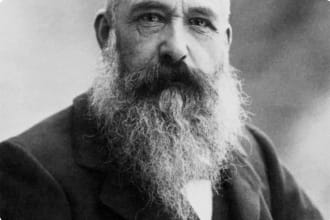
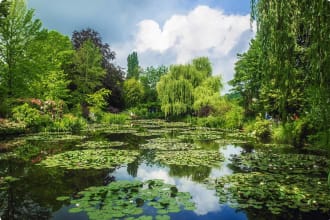
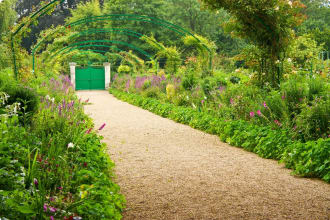
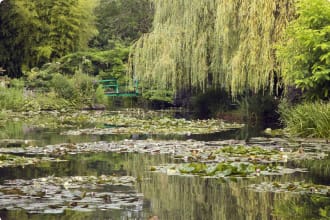
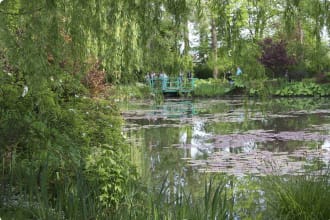
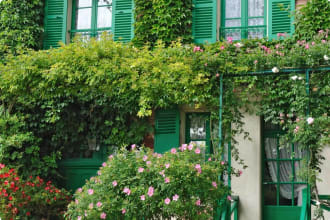
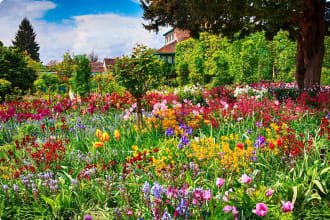
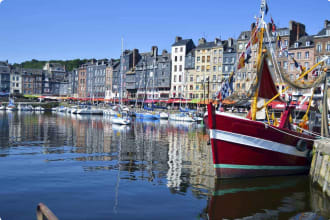
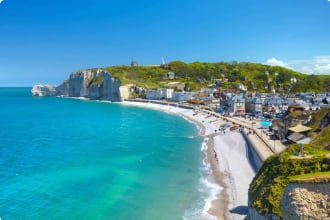
Itinerary
20 days
Day 1: Paris
Upon arrival in Paris, we make our own way to our hotel. The Odyssey Program Leader will greet the group and the rest of the day is free until we meet again in the evening for our welcome dinner.
Day 2: Paris
We will be staying in a centrally located Paris apartment, with easy access to the metro. We will take the metro to the Musée MarmottanMarmottan Monet Museum, France Monet, which houses the single largest collection of Monet’s paintings. We will be treated to a discussion that will introduce Claude Monet and his family to us, as well as his early years as an artist.
Day 3: Paris
Today we will have discussions on Monet and Impressionism, and his decades-long friendship with the French Prime Minister Georges Clemenceau (1841-1929), supported by our visits to Musée D’Orsay and Musée de l’Orangerie. These two museums have become part of the same publicly administered establishment since June 2010.
Monet’s friendship with the former Prime Minister, nicknamed the ‘Tiger’ of French politics, was in many ways an unlikely one, given that Monet had never had much interest in politics and apparently had never voted. But Clemenceau and Monet had known each other since they were young men in Paris in the 1860s, shared a passion for gardens and cars, and Clemenceau had been a supporter of the Impressionists when their art had been controversial. Monet donated the Water Lilies panels to France through Clemenceau, but decided not to part with the paintings until after his death. The Water Lilies installation is housed in Musée de l’Orangerie, and other Impressionist paintings can be found in Musée D’Orsay.
Day 4: Paris - Giverny - Argenteuil - Paris
Today we will be travelling from Paris to Giverny to view Monet’s beloved garden and water lily pond that inspired his famous paintings.
Monet’s garden in Giverny spans more than two acres, divided by a road that used to be railroad tracks connecting Vernon and Gisors. On one side of the road in front of the artist’s restored pink stucco house with green shutters is the Clos Normand (the Norman Enclosure) with flowers planted in rows and grouped according to colour, not unlike an artist’s palette. Across the road is the ethereal water lily garden, a pond with a bridge painted green instead of the traditional red colour used in the Japanese bridges that inspired it, framed by wisteria, bamboos, maple trees, and Japanese peonies, with nymphéas (water lilies) dotting the pond.
We will explore the area and learn more about the artist and his home life. On our way back to our hotel, we will take a stop at Argenteuil on the banks of the Seine before returning to our hotel. Monet lived and painted in Argenteuil with his family from 1871 to 1878, where he had a rented house with a garden.
Day 5: Paris
Today is our free day to spend in Paris. Use this time to relax or explore the city!
Day 6: Paris - Le Havre
Today we will travel from Paris through the French countryside to reach Monet’s hometown, Le Havre. Le Havre has been inscribed on the UNESCO World Heritage Site list since 2005. We will have a tour of the town and see the harbour that Monet painted in his famous Impression, Sunrise.
Located on the Normandy coast, Le Havre was bombed heavily during World War II and was subsequently rebuilt by Belgian architect Auguste Perret.
One site that somehow survived the bombing is the 16th century Cathédrale Notre-Dame, the oldest building in the town centre, which we will visit today. We will also visit Le Havre’s cultural centre and famous 20th century architectural landmark, Le Volcan.
Day 7: Le Havre
We continue our exploration of Le Havre. Among our stops are the André Malraux Museum of Modern Art or MuMa Le Havre, the postwar church Église St-Joseph, and the hilltop Jardins Suspendus (Hanging Gardens).
Day 8: Le Havre - Sainte-Adresse - Etretat
From Le Havre we travel four kilometres for a stop at Sainte-Adresse, where a young Monet stayed in 1867 in the home of his aunt, Sophie Lecadre. Here Monet continued painting seascapes: Sainte-Adresse, The Beach at Sainte-Adresse, and Regatta at Sainte-Adresse. Its Chapelle Notre-Dame des Flots is dedicated to those lost at sea.
We push on to Etretat, a fashionable French resort town developed in the 19th century. It was a favourite holiday destination by the Parisians, and continues to be popular among tourists today. The picturesque resort, framed by incredible white cliffs, drew Monet and other Impressionists to its shoreline. Monet lived here in 1868 and returned to it several times in subsequent years. We will settle in our accommodation and enjoy a dramatic view of the sunset by the beach.
Day 9: Etretat
Today we will see the main sights of Etretat, which include the Etretat Gardens; Le Clos Lupin, home of author Maurice LeBlanc who created the literary gentleman burglar, Arsène Lupin; and Château des Aygues, the former summer residence of the Queen of Spain. Of course, we will continue to enjoy a view of Etretat’s white cliffs.
Day 10: Etretat - Dieppe - Etretat
Today we take a trip to another coastal town, Dieppe, where Monet painted its cliffs. Dieppe was an important French port in the 16th century and was fought over by the English and the French in the Hundred Years’ War. It became a popular beach resort among English and French artists, including Monet, Pissarro, Renoir, Gauguin, Oscar Wilde, and Virginia Woolf.
In Dieppe, we will have a tour of Château-Musée, a clifftop medieval castle turned museum. Offering panoramic views of the town, Château-Musée was largely built after the English had been pushed out by the French at the end of the Hundred Years’ War. The castle now holds collections of Impressionist paintings, as well as exhibitions that speak to the town’s long involvement in maritime trade, including one of the largest collection of ivory carvings in France.
We will enjoy dinner at a seafood restaurant at the Dieppe harbour before heading back.
Day 11: Etretat
Today is a free day to spend in Etretat.
Day 12: Etretat - Honfleur
From Etretat, we will transfer to Honfleur, where Monet lived in 1864 and painted Rue de la Bavolle, Honfleur. England and France took turns occupying this strategic trade port throughout the Hundred Years’ War in the 14th to 15th centuries. Its picturesque harbour (Vieux Bassin, “old dock”) dates back to the 17th century and has inspired many artists.
Honfleur-born painter Eugène Boudin persuaded Monet, then only 18, to try his hand at painting landscapes, and might have also influenced him to make Honfleur his temporary home. Today, we will be visiting the Boudin Museum and Sainte-Catherine church, the largest wooden church in France, and take a walk around the harbour and the town centre.
Day 13: Honfleur - Rouen
From Honfleur, we will travel to Rouen, whose Gothic cathedral inspired Monet’s 31-canvas Rouen Cathedral series. Painted between 1892 to 1894, Monet painted the cathedral’s facade over and over, using smaller strokes and focusing on composition, colour, and the effects of light. Painting in a room across the square from the cathedral, Monet later reworked these canvases in his studio in Giverny.
Today, we will visit the cathedral that inspired Monet. The Rouen Cathedral has the tallest church spire in France and is an impressive example of Gothic architecture.
Day 14: Rouen
Rouen is as vibrant as the cathedral and Monet’s series of paintings. Its history is entwined with that of medieval English history. Invaded by the Normans in the 9th century, Rouen fell under the English crown following the Norman Conquest of England. It was captured by France in the early 13th century, and suffered through the Hundred Years’ War (it is here where Joan of Arc was burned at the stake) and the Wars of Religion. Today, we will spend time to explore its historic quarter and main sights. We will also be visiting Rouen’s Musée des Beaux-Arts, which holds the second-largest collection of Impressionist works in France.
Day 15: Rouen
Today is a free day in Rouen.
Day 16: Rouen - Giverny - Argenteuil - Paris
Having seen and learned the histories of the places that inspired Monet, we begin our loop back to the start of our tour.
We will travel from Rouen to Giverny, and enjoy a second visit to Monet’s home and garden. We will stop at Argenteuil, and return to Paris for the night.
Day 17: Paris
Today we will return to the Musée de l’Orangerie and Musée D’Orsay to gaze once again at Monet’s paintings.
Day 18: Paris
Today we return to the Musée Marmottan Monet.
Day 19: Paris
Today we have the day to spend at our leisure. In the evening we meet again as a group for our farewell dinner.
Day 20: Paris
The end of breakfast marks the end of the tour and our services.
Includes / Excludes
What’s included in our Tour
- 20 nights hotel accommodation.
- 20 breakfasts, 2 lunches, and 10 dinners.
- Touring by comfortable modern coach
- Transport and field trips as indicated.
- Applicable entry fees and services of local guides.
- Services of a Tour Leader.
- Gratuities and necessary tips.
- Detailed tour information booklet.
What’s not included in our Tour
- International airfares and departure taxes.
- Comprehensive travel insurance.
- Items of a personal nature such as telephone calls and laundry.
Participants must be able to carry their own luggage, climb and descend stairs, be in good health, mobile and able to participate in 3-5 hours of physical activity per day, the equivalent of walking / hiking up to 8 kilometers per day on uneven ground.
Book now
Make it a private tour
Easing your journey
Crossing international borders with restrictions
The list of requirements to travel internationally has changed and will continue to change for several years. Odyssey is here to assist you in managing your way through these requirements:
For more information see our Crossing international borders with restrictions page.
Book With Confidence
If less than 30 days before your tour starts you are unable to travel as a result of Government travel restrictions, Odyssey Traveller will assist you with a date change, provide you with a credit or process a refund for your booking less any non-recoverable costs.
See Terms and conditions for details.
Peace of Mind Travel
The safety of our travellers, tour leader, local guide and support staff has always been our top priority and with the new guidelines for public health and safety for keeping safe for destinations around the world, we’ve developed our plan to give you peace of mind when travelling with us.
See Peace of Mind Travel for details.
Reading List Download PDF
Monet Triumph Of Impressionism
Wildenstein Daniel
Master of the sublime: The essential Impressionist
Along with Turner, no artist has sought more than Claude Monet (1840–1926) to capture light itself on canvas. Of all the Impressionists, it was the man Cézanne called “only an eye, but my God what an eye!” who stayed completely true to the principle of absolute fidelity to the visual sensation, painting directly from the object.
It could be said that Monet reinvented the possibilities of color, and whether it was through his early interest in Japanese prints, his time in the dazzling light of Algeria as a conscript, or his personal acquaintance with the major painters of the late 1800s, what Monet produced throughout his long life would change forever the way we perceive both the natural world and its attendant phenomena. The high point of his explorations was the late series of waterlilies, painted in his own garden at Giverny, which, in their moves toward almost total formlessness, are really the origin of abstract art.
This biography does full justice to this most remarkable and profoundly influential artist, and offers numerous reproductions and archive photos alongside a detailed and insightful commentary.
Monet: The Late Years
George T. M. Shackelford , Claire M. Barry, Simon Kelly, Emma Cauvin, Claire DurandGÇôruel Sno, Marianne Mathieu
In the later years of his life, Claude Monet stayed close to home, turning to his extraordinary garden at Giverny for inspiration. The garden became a laboratory for the artist's concentrated study of natural phenomena and for a revolutionary shift in the appearance and execution of his paintings. This beautiful publication examines the last phase of Monet's career, beginning in 1913, bringing together approximately 60 of his greatest works from this period. More specifically, Monet: The Late Years focuses on the series that Monet invented and reinvented at Giverny, reevaluating many large-scale works that have long been considered preparatory studies, reexamining their relationship to and status as finished works. Essays by a roster of distinguished scholars address topics such as Monet's plans for displaying his late paintings, the mechanics of his painting technique, and the critical and market reception of these works. Through this visually stunning reassessment, Monet's late works, still astonishing a century later, recast the titan of Impressionism as a radical modern painter.
The Private Lives Of The Impressionists
Sue Roe
"Manet, Monet, Pissarro, Cezanne, Renoir, Degas, Renoir, Sisley, Berthe Moriost and Mary Cassatt. Their contemporaries branded them as lunatics, but today this is a roll-call of great artists, whose paintings evoke a unique atmosphere of harmony- languid landscapes flooded with light, shop-workers dancing on their day off, bars and gas-lit streets, the sunlit beach at Trouville. We all know these dazzling pictures but how well do we know the Impressionists as people?This book tells their story. Sue Roe shows how the early leaders of the group first met in the Paris studios and lived and worked closely together for nearly twenty years. Painting outdoors, meeting in cafes, they supported each other and shared emotional and financial difficulties. Defying the hide-bound rules of the salon, they staged joint exhibitions and rebelled against artistic prejudice, moral tyranny and social hierarchy. Often rejected by their horrified parents, they led volatile and precarious lives- their wives were servants, models, flower-sellers and, although their paintings today sell for millions, they were barely able to support their families. This intimate, colourful, superbly researched account
Mad Enchantment: Claude Monet and the Painting of the Water Lilies
Ross King
Claude Monet's water lily paintings are among the most iconic and beloved works of art of the past century. Yet these entrancing images were created at a time of terrible private turmoil and sadness for the artist. The dramatic history behind these paintings is little known; Ross King's Mad Enchantment tells the full story for the first time and, in the process, presents a compelling and original portrait of one of our most popular and cherished artists.
By the outbreak of war in 1914, Monet, then in his mid-seventies, was one of the world's most famous and successful painters, with a large house in the country, a fleet of automobiles and a colossal reputation. However, he had virtually given up painting following the death of his wife Alice in 1911 and the onset of blindness a year later. Nonetheless, it was during this period of sorrow, ill health and creative uncertainty that – as the guns roared on the Western Front – he began the most demanding and innovative paintings he had ever attempted.
Encouraged by close friends such as Georges Clemenceau, France's dauntless prime minister, Monet would work on these magnificent paintings throughout the war years and then for the rest of his life. So obsessed with his monumental task that the village barber was summoned to clip his hair as he worked beside his pond, he covered hundreds of yards of canvas with shimmering layers of pigment. As his ambitions expanded with his paintings, he began planning what he intended to be his legacy to the world: the 'Musée Claude Monet' in the Orangerie in Paris.
Drawing on letters and memoirs and focusing on this remarkable period in the artist's life, Mad Enchantment gives an intimate portrayal of Claude Monet in all his tumultuous complexity, and firmly places his water lily paintings among the greatest achievements in the history of art.
Claude Monet (Portrait of an Artist)
Lucy Brownridge
Learn about one of the worlds favourite painters - Claude Monet - in this unique biography series, which depicts the story of an artist 's life through their own masterworks. Claude Monet is one of the best loved artists of all time. Find out how this special young painter strove to capture light and feeling in his paintings and how together with a group of talented friends, he came to start the most famous art movement of all time, Impressionism. In his long life he experienced war and heartbreak, love and the joy of family. See how his life shaped each piece of art he made and that throughout it all he never stopped trying to paint the ever changing light and glimmering water. In the end he built himself a garden filled with both, with waterlilies floating on dappled ponds setting the scene for his last, infamous masterpieces. A Monet masterpiece is featured on every spread. This art story also includes a closer look at 10 of Monets masterpieces at the back.


